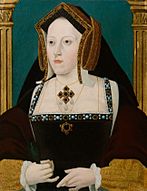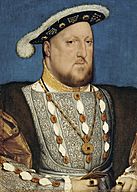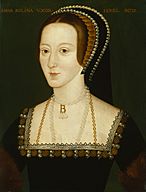Richard Roose facts for kids

Richard Roose (also known as Richard Rouse, Richard Cooke or Richard Rose) was accused in early 1531 of poisoning members of the household of the Englishman John Fisher, Bishop of Rochester, for which he was executed. Nothing is known of Roose (including his real name) or his life outside of the case; he may have been Fisher's household cook, or less likely, a friend of the cook, at Fisher's residence in Lambeth.
Roose was accused of adding a white powder to porridge given to Fisher's dining guests and servants, as well as beggars to whom the food was given as charity. Two people—a member of Fisher's household, Burnet Curwen, and a beggar, Alice Tryppyt—died. Roose claimed that he had been given the powder by a stranger and claimed it was intended to be a joke. Fisher survived the poisoning as, for an unknown reason, he ate nothing that day. Roose was arrested. King Henry VIII—who already had a morbid fear of poisoning—addressed the House of Lords on the case and was probably responsible for an act of parliament which attainted Roose and retroactively made murder by poison a treasonous offence. Roose was executed at London's Smithfield in April 1532.
Fisher was already unpopular with the King as Henry wished to annul his marriage to Katherine of Aragon to marry Anne Boleyn, an act the Church forbade. Fisher was vociferous both in his defence of Katherine and attacks on Boleyn, and contemporaries rumoured that the poisoning at Lambeth could have been either her or her father's responsibility, with or without the knowledge of the King. There appears to have been at least one other attempt on Fisher's life when a cannon was fired towards Fisher's residence from the direction of her father, Thomas, Earl of Wiltshire's, house in London; on this occasion, no-one was hurt, but much damage was done to the roof. These two attacks, and Roose's execution, seem to have prompted Fisher to leave London before the end of the sitting parliament, to the King's advantage.
Fisher was put to death in 1535 for his opposition to the Acts of Supremacy that established the English monarch as head of the Church of England. Henry eventually broke with the Catholic Church and married Boleyn, but his new Act against Poisoning did not long outlive him, as it was repealed almost immediately by his son Edward VI. The Roose case continued to ferment popular imagination and was still being cited in law into the next century. Historians often consider his execution as a watershed in the history of attainder, which traditionally acted as a corollary to common law rather than replacing it. It was a direct precursor to the treason attainders that were to underpin the Tudors'—and particularly Henry's—destruction of political and religious enemies.
Images for kids
-
Roose's place of execution: Smithfield, as shown on the Agas map of 1561





